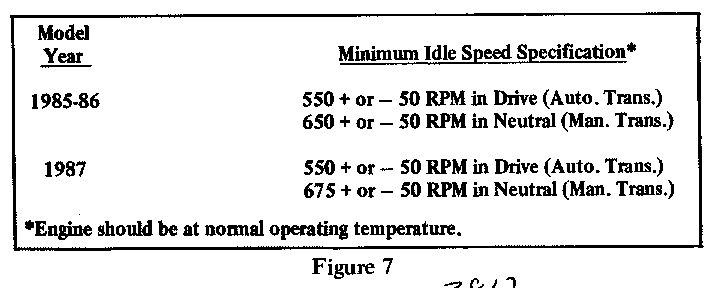ENG. MAY INTERMITTENTLY STALL CHECK FOR RESIDUE ON THROTTLE

MODELS AFFECTED: 1986-1987 CIMARRON WITH V-6 ENGINE (VIN W)
Some 1986-1987 Cimarrons may experience a stall condition following start-up on a warm engine. These vehicles may also stall during deceleration.
This condition may be caused by residue accumulating inside the throttle body bore behind the throttle plate. The residue limits air ftow past the throttle plate when in the idle position. Even what appears to be a small amount of residue can be enough to limit air flow.
To repair this condition, the following steps should be performed:
1. Measure the minimum idle speed following the procedures described in Section 6E3-C2 of the appropriate model year Service Information Manual.
2. If the minimum idle speed is less then:
Auto transmission - 550 +/- 50 RPM in drive
Manual transmission - 650 +/- 50 RPM in neutral (1986) - 675 +/- 50 RPM in neutral (1987)
Proceed to Step 3. If the minimum idle speed is greater then specified above, refer to Section 6E3-B, Symptoms, "Rough, Unstable or Incorrect idle, Stalling" in the appropriate model year Service Manual and perform the procedures outlined in that section.
3. Disconnect the negative battery terminal.
4. Remove the mass airflow duct at the throttle body.
5. Cover the throttle position sensor (TPS) and Idle Air Control Valve (IACV) to protect them from overspray.
6. Clean the throttle body bore in the area behind the throttle plates. Use a shop towel with GM Top Engine Cleaner (P/N 1052626), AC-Delco Carburetor Tune-Up Conditioner (P/N X66-A), or any equivalent cleaner that does not contain methyl ethyl ketone.
7. Reinstall the mass airflow duct. Connect the negative battery terminal.
8. Recheck the minimum idle speed per Service Manual procedures. Adjust to the specifications given above, if necessary.
For warranty purposes, use Labor Operation T6229 at 0.5 hours.

General Motors bulletins are intended for use by professional technicians, not a "do-it-yourselfer". They are written to inform those technicians of conditions that may occur on some vehicles, or to provide information that could assist in the proper service of a vehicle. Properly trained technicians have the equipment, tools, safety instructions and know-how to do a job properly and safely. If a condition is described, do not assume that the bulletin applies to your vehicle, or that your vehicle will have that condition. See a General Motors dealer servicing your brand of General Motors vehicle for information on whether your vehicle may benefit from the information.
